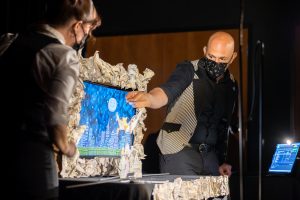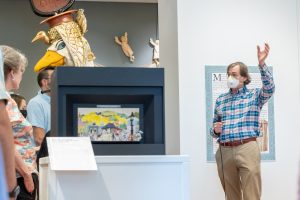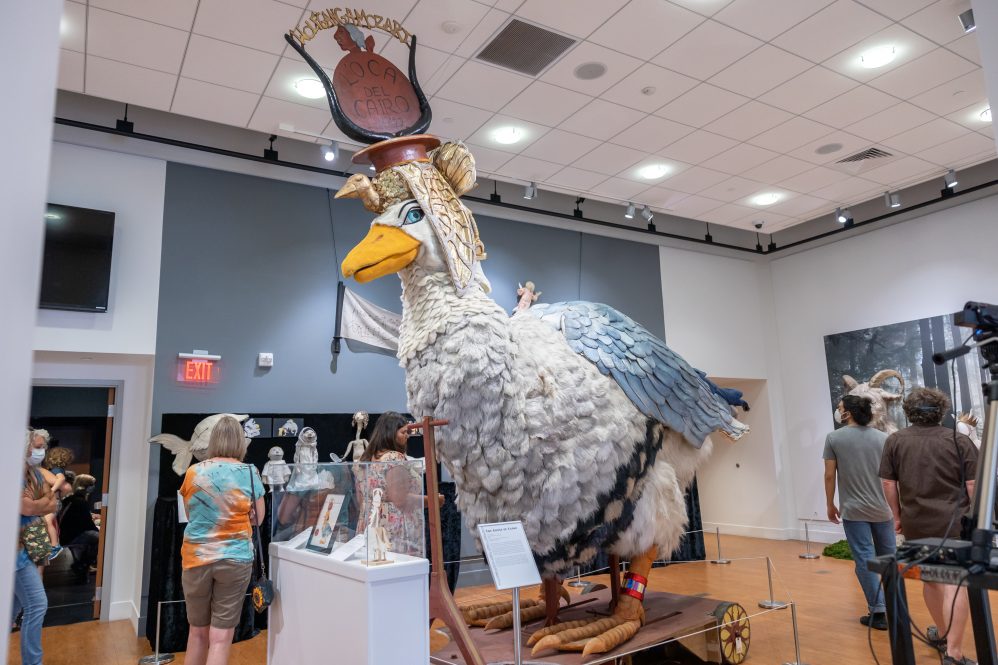True enough, Maurice Sendak might be best known for his 1963 book “Where the Wild Things Are,” but what many may not know is the Brooklyn-born illustrator made a career of collaboration, allowing his art to leave the confines of paper and come to life on stage.
From personifying Mozart’s String Quartet No. 19 in C Major in the story of a young boy, his mother, a bird, and a fish to creating larger-than-life characters from “The Nutcracker” for the Pacific Northwest Ballet’s 1983 adaptation, the author, who lived in Ridgefield for 40 years until his death in 2012, spent significant time with theatrical craftsmen to make operas, ballets, puppet shows, and his own most popular story awaken in live performance.
“Sendak was interested in puppetry, even though he was not a puppeteer himself,” Ballard Institute and Museum of Puppetry Director John Bell says. “As a visual artist, he was intrigued by images, gestures, choreography, and story. He was interested in the ways that graphic design and visual art can move in performance. This manifested itself in a lot of different ways.”
“Swing into Action: Maurice Sendak and the World of Puppetry” puts many of those examples on display at the Ballard, with the enormous Goose of Cairo from the 1982 Kansas City production of Mozart’s opera “L’Oca del Cairo” as the exhibit’s centerpiece.

“Not every theater designer would revel in the idea of creating this giant puppet of a Goose of Cairo, but Sendak really did,” Bell, who curated the show, says. “He loved the idea of making this goose that’s a little bit goofy, but it has this Cleopatra headdress and pays homage to the composer by spelling out Mozart’s name on the crown. He’s collaborating with Mozart, in a sense, by creating this giant puppet for an old, silly love story.”
Matthew Sorensen ’22 MFA, who designed the exhibit and will serve as the Ballard’s interim co-director with Emily Wicks this fall while Bell is on sabbatical, says that gathering each piece in the show was an act of collaboration in its own right, not just with the Maurice Sendak Foundation, but also with family members of artists who worked on projects with Sendak and Warner Bros. Pictures, which produced the 2009 Spike Jonze film version of “Where the Wild Things Are.”
The film, Bell notes, marries the old art of puppetry, through costumed actors portraying Max and Wild Things Alexander and Douglas – all on display at the Ballard – and the new technology of animatronic masks created by Jim Henson’s Creature Shop and post-production digital animation to make the characters truly come alive.
“In the documentary ‘Tell Them Anything You Want: A Portrait of Maurice Sendak,’ Jonze and Sendak sit together and talk about the differences between the book and the movie and how excited Sendak was to have somebody else put a spin on his story,” Sorensen says. “Just in terms of setting, Max runs away in the film but in the book he’s in his bedroom and it transforms. These differences mean a lot to the people Sendak is collaborating with, and he really likes to honor that and was excited by it.”
He loved when people would adapt his work for show.
One of his favorite collaborations was with puppeteer Amy Luckenbach, who adapted “Where the Wild Things Are” with hand puppets for the small stage in 1976 and first performed it in a church outside Florence, Italy, before later staging it in piazzas around the city.
Many years later, she worked with Sendak directly to create puppets based on his “Fantasy Sketches and Life of Mozart” series, including Mozart’s String Quartet No. 19 in C Major, for New Haven’s International Festival of Arts and Ideas in 2001, and again to readapt the Wild Things puppets for a new staging of the Oliver Knussen’s opera in 2004.
As Bell looks over the many Luckenbach puppets in the exhibit, he says he can see “how and why Sendak really liked what she was doing. I think she understood his aesthetic and was able to interpret that aesthetic in these cloth, direct manipulation puppets. I feel her design here as well as Sendak’s.”

The film that plays as part of the Ballard exhibit shows Sendak working with craftsmen to sculpt an early version of the Wild Things balloon for the Macy’s Thanksgiving Day Parade, telling them exactly how the horns on the character Moishe should look. Bell says that in other exchanges with balloon designers, Sendak critiques sketches of Moishe’s palms and feet, saying they look too similar and need to be more distinct.
“He’s really engaged in that collaboration with these technicians of giant inflatable puppets,” Bell says. “As puppeteers, we’re also engaged in the nitty-gritty. We’re the people who have hands on the tools and are building things. He was so interested in that – what kind of wood are you using, what kind of tool can build that – from a puppeteer’s perspective.”
Sorensen agreed, “He was excited to talk with the technicians and craftsmen on these projects in their language and learn about what they do. Even as he got older, his advanced age was not a deterrent; it was propulsion, which I love.”
“Swing into Action: Maurice Sendak and the World of Puppetry” is on view at the Ballard Institute and Museum of Puppetry through Dec. 16. The museum is open Wednesdays through Saturdays, 10 a.m. to 4 p.m.



